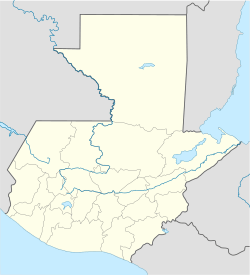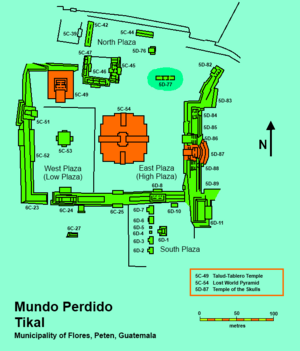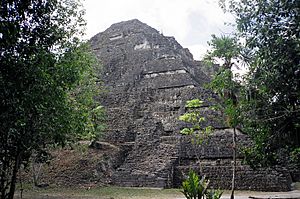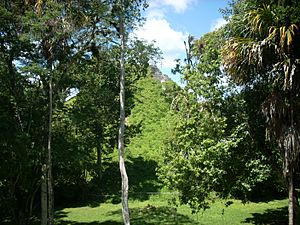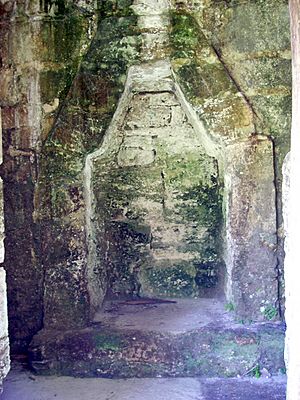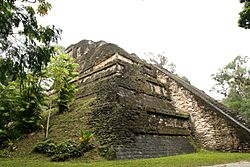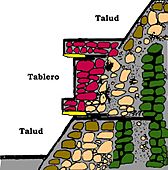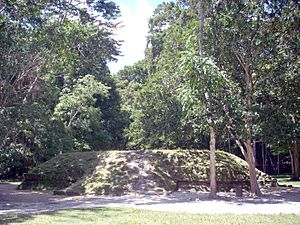Mundo Perdido, Tikal facts for kids

The Lost World Pyramid (Structure 5C-54) dominates the complex. View of the restored west face.
|
|
| Location | Flores |
|---|---|
| Region | Petén Department, |
| Coordinates | 17°13′12.17″N 89°37′40.56″W / 17.2200472°N 89.6279333°W |
| History | |
| Founded | c. 700 BC |
| Abandoned | c. AD 900 |
| Periods | Preclassic–Terminal Classic |
| Cultures | Maya civilization |
| Site notes | |
| Excavation dates | 1979–1985 |
| Archaeologists | William R. Coe; Juan Pedro Laporte IDAEH |
| Architecture | |
| Architectural styles | Talud-tablero, Preclassic & Classic Maya |
| Architectural details | Number of monuments: 1 Number of temples: 5+ |
| Restored by Proyecto Nacional Tikal (1979–1985) Responsible body: IDAEH | |
The Mundo Perdido (which means "Lost World" in Spanish) is a very old and important area at the ancient Maya city of Tikal. Tikal is located in the northern part of Guatemala. This complex is the largest ceremonial site from the Preclassic period.
The Mundo Perdido was built as a special "E-Group" complex. This means it had a pyramid that lined up with three temples on a platform to the east. This setup helped the Maya track the sun's movements. Over time, the Mundo Perdido complex was rebuilt many times. Around AD 250–300, its building style was influenced by the big city of Teotihuacan in Mexico. This included using a style called talud-tablero, which has sloping and vertical panels.
During the Early Classic period (around AD 250–600), the Mundo Perdido became one of the two main centers of Tikal. The other was the North Acropolis. From AD 250 to 378, it might have been a special burial place for Maya rulers. Archaeologists from the University of Pennsylvania gave the complex its name, "Mundo Perdido."
The main area of the complex has a large plaza around the Lost World Pyramid (Structure 5C-54). This plaza is divided into two parts: the High Plaza and the Low Plaza. The High Plaza is near the Lost World Pyramid. The Low Plaza is to the west of the pyramid. The whole complex covers about 60,000 square meters (about 645,000 square feet).
Guatemalan archaeologists have made big discoveries in the Mundo Perdido since the 1970s. The National Tikal Project worked here from 1979 to 1985. They also restored some of the main buildings. The Mundo Perdido was the first major building complex at Tikal. It was also the last one to be used before the city was abandoned.
Contents
Exploring the History of Mundo Perdido
Early Beginnings (Preclassic Period)
The Mundo Perdido was built in six main stages. Four of these stages happened during the Preclassic period. Each time, a new version of the E-Group (the Lost World Pyramid and the East Platform) was created. The oldest signs of people living at Tikal, from before 700 BC, were found here. These were mostly old rubbish, not buildings.
The complex started to take shape around 600 BC. At this time, structures were added to flat, man-made platforms. The buildings became taller and more complex over time. The Lost World Pyramid and the East Platform form the oldest E-Group in Tikal. During the Late Preclassic period, a raised road called a causeway was built. It connected the Mundo Perdido to the North Acropolis. This causeway also helped guide rainwater into a reservoir. Around AD 100, three temples were built on the East Platform.
Growth and Change (Early Classic Period)
Around AD 250, at the start of the Early Classic period, the Mundo Perdido plaza was made bigger. This made the Lost World Pyramid the center of the complex. After this, many buildings in the Mundo Perdido were updated. They were changed to match new building styles in the city.
A small platform was added to the East Platform. It had holes that might have held banners. This platform covered a large pit. Inside the pit were the bodies of seventeen people. These people, including men, women, and children, were likely offered during a special ceremony. In the 4th century AD, the first version of Structure 5D-82 was built. It was located north of the East Platform. Later in the 4th century, six tombs were built in the East Platform. These tombs contained fancy pottery, including pots shaped like monkeys and macaws. The high quality of these items shows that the buried people were important leaders in Tikal.
After AD 378, a new ruler named Siyaj K'ak' came to power. The main place for royal burials then moved from the Mundo Perdido to the North Acropolis. From the 4th to the 6th century, the talud-tablero building style became very popular in the Mundo Perdido.
Later Years (Late Classic Period)
During the 7th century, the East Platform changed a lot. A new version of Temple 5D-87 was built. This temple faced away from the Mundo Perdido. Around AD 700, this version was covered, and another new version was built on top. This made Temple 5D-87 one of the tallest buildings in the Mundo Perdido. This new temple changed how the complex was used for ceremonies.
Around this time, twin pyramid complexes also started to be used in Tikal. This showed a big change in how the city was organized. During the Late Classic, it became harder to get into the Mundo Perdido. New buildings blocked some entrances. The causeway that connected it to the North Acropolis was also no longer used. A new palace complex was built in the northern part of the Mundo Perdido. This happened during the 7th and 8th centuries AD. This was a big change because the Mundo Perdido had only been used for ceremonies before. The palace showed that important people lived in the complex. They were likely involved in running the city.
The Mundo Perdido continued to be an important burial site in the 8th and 9th centuries. The final version of the Talud-Tablero Temple had three burials of important people. Their valuable offerings suggest they might have been part of the royal family. These burials date to the late 8th century, during the time of King Yax Nuun Ayiin II.
Final Chapter (Terminal Classic Period)
Tikal as a whole started to decline during the Terminal Classic period. Some parts of the city were even left empty. However, the Mundo Perdido continued to be a busy place for ceremonies. There is evidence of new burials, pottery, and tools. There was also a lot of building activity. The main Late Classic buildings got new benches. Access routes to the complex were also changed. Activity was focused in the northern part of the Mundo Perdido. This might be because it was close to the Temple Reservoir, which supplied water.
The greatest number of people lived in the palace next to the Talud-Tablero Temple. This continued activity, including complex building projects, shows that important people still lived in the palace. This was right before the city was completely abandoned. People continued to live in the northern part of Mundo Perdido for at least 100 years after the rest of Tikal was abandoned. This was probably because of the nearby water supply and ongoing ceremonies. While the northern part of the Mundo Perdido was still used, the rest of the complex was partly abandoned. The Mundo Perdido was completely left empty during the Terminal Classic. Very few signs of activity have been found from after this time.
Modern Discoveries
The University of Pennsylvania first explored the Lost World Pyramid. They dug test holes and trenches. They found surprisingly old pottery pieces deep inside the pyramid. This made the complex a focus for later studies. The National Tikal Project started a big study of the Mundo Perdido in September 1979. They first cleared the forest from the Lost World Pyramid. The main part of their work lasted until 1982. Both the Lost World Pyramid (5C-54) and the Talud-Tablero Temple were dug up and restored from 1980 to 1982. Soon after the work began, bad weather caused damage to several buildings. The east side of the Lost World Pyramid even collapsed.
Key Structures of Mundo Perdido
Archaeologists have divided the Mundo Perdido complex into different areas. William R. Coe called them the High Plaza and the Low Plaza. The High Plaza is around the Lost World Pyramid. The Low Plaza is to its west.
More recently, the National Tikal Project divided the complex into four plazas: North, East, West, and South. These are named based on their location around the Lost World Pyramid (5C-54).
The E-Group: An Ancient Observatory
The original heart of the Mundo Perdido was an E-Group. This was a special setup used to watch the sky. The east stairway of the Lost World Pyramid (5C-54) was the viewing spot. The three original temples on the East Platform (5D-84, 5D-86, and 5D-88) were markers. They helped the Maya track where the sun rose during the equinoxes (when day and night are equal) and solstices (the longest and shortest days). This E-Group was rebuilt seven times. The oldest version dates back to the end of the Middle Preclassic period.
The Lost World Pyramid
The Lost World Pyramid (also called Structure 5C-54 or the Great Pyramid) was built during the Late Preclassic period. It is the main building in the Mundo Perdido complex. Today, it stands about 31 meters (102 feet) tall. Its base is about 67.5 meters (221 feet) wide. Building this pyramid was one of the biggest projects ever in Tikal.
The pyramid has stairs on its west side, which were once flanked by huge masks. The final version of the pyramid had stairs on both the east and west sides that went all the way to the top. It also had stairs on the north and south sides that went up to the eighth of its ten levels. This building was one of the largest in ancient Mesoamerica during the Late Preclassic. It was built with very large stone blocks. The pyramid was rebuilt many times, just like the rest of the complex. The version you see today is the fifth one, built around AD 250. When it was built, it was the tallest building in Tikal.
The pyramid's stepped levels have vertical panels. These were early forms of the talud-tablero style. Traces of paint show that the outside of the pyramid was once painted blue and red.
| Version | Date | Height | Width (N-S) | Levels |
|---|---|---|---|---|
| 1st | c. 600 BC | 2.94 m (9.6 ft) | 23.46 m (77.0 ft) | 3 |
| 2nd | c. 500 BC | 7.8 m (26 ft) | 37.25 m (122.2 ft) | 4 |
| 3rd | c. 300 BC | 9.46 m (31.0 ft) | 37.67 m (123.6 ft) | 6 |
| 4th | c. 1 BC | 18 m (59 ft) | 60 m (200 ft) | 8+ |
| 5th | c. AD 250 | 30.7 m (101 ft) | 72 m (236 ft) | 10 |
Each new version of the Lost World Pyramid was bigger than the last. They were not built exactly on top of the old one. This was done to keep the E-Group plaza area clear. This also meant that the east side of the older pyramid was destroyed each time a new one was built over it.
Pyramid's First Version
The earliest pyramid was built around 600 BC. It was built on a leveled area. This first version likely had three stepped levels with stairs on all four sides. It was about 23.46 meters (77.0 feet) wide and 2.94 meters (9.6 feet) tall.
Pyramid's Second Version
The second version was built between 600 and 400 BC. Two adult men were buried under the top platform of this pyramid. They didn't have any offerings with them. However, their skulls were shaped, and their teeth were decorated. This suggests they were important people. Archaeologists believe they were offered during the building of this new pyramid. This version had four stepped levels. It was about 37.25 meters (122.2 feet) wide and 7.8 meters (26 feet) tall.
Pyramid's Third Version
The third version was built between 400 and 200 BC. It was part of the formal E-Group design. This version was 37.67 meters (123.6 feet) wide and 9.46 meters (31.0 feet) tall. Building it damaged the second version underneath. This third version was a pyramid with six stepped levels. It had a raised platform at the top made of stone blocks. This platform had rounded corners. The pyramid had giant masks next to the main stairways. A burial (PNT-001) was found inside this version of the pyramid.
Pyramid's Fourth Version
The fourth version of the pyramid was much larger. It was built between 200 BC and AD 200. It stood 18 meters (59 feet) tall and was 60 meters (200 feet) wide. This was the biggest jump in size between any two versions. It also had giant masks. However, this version was not built very strongly. It needed to be reinforced often. The architects learned from this mistake, and these building methods were not used again. This version was used for a short time before being replaced.
Pyramid's Fifth Version
The fifth and final version of the Lost World Pyramid was built around AD 200-300. When archaeologists dug it up, they found it was not well preserved. Its sides had sunk in many places. This final pyramid had ten levels and was 30.7 meters (101 feet) tall. It was about 72 by 67.5 meters (236 by 221 feet) at its center. This makes it the most massive building project at Tikal.
The fifth version started with 8 levels. A ninth level was added in the 4th century, and the tenth level was added later. Each stairway had large tablero panels. A large stone slab was found embedded in a bench at the top. It might have been a stela (a carved stone monument) that was placed there later. Many pieces of pottery were found on the pyramid. This shows that the building remained important. A well-preserved limestone model of a building complex was also found. It showed pyramids and a Mesoamerican ballcourt.
The East Platform
The East Platform separates the Mundo Perdido from the Plaza of the Seven Temples. This platform is one of the oldest structures in Tikal. It started to look like its final form around AD 100. At that time, the first versions of three temples (5D-84, 5D-86, and 5D-88) were built on it. In the 5th century AD, the platform was updated with a huge talud-tablero design.
- Structure 5D-82 is the northernmost building next to the East Platform. The first version of this building was built in the 4th century AD. It was a round platform with one room. It was decorated with a fancy stucco frieze. This frieze had human-like figures and glyphs. Archaeologists believe the main figure is the god Itzamna.
- Structure 5D-84 is near the north end of the east side. It has three rooms. It was one of the first three buildings on the East Platform.
- Structure 5D-85 is a double platform. It provides access to the Plaza of the Seven Temples.
Structure 5D-86 has parts of giant masks on its front. It dates to the Late Classic period. Stela 39 was found inside this building. The first version of this building was built around AD 100. It had three rooms. The middle room is special because it has two giant animal-like masks. This is the only known example from the Late Preclassic Maya world where such masks were placed inside a building. The first royal tomb in the Mundo Perdido was placed in this building.
- Structure 5D-87 is also known as the Temple of the Skulls. It is the third largest temple in the Mundo Perdido complex. A new version of this temple was built on top of an older one in the 7th century AD. This new version faced away from the Mundo Perdido. It had one room with five doorways that faced the Plaza of the Seven Temples. Around AD 700, this version was covered, and a new one was built on top. This made it one of the tallest buildings in the Mundo Perdido. This version had a four-level platform with a stairway. The stairway had a special arched niche. The base of this niche had three sculpted skulls.
- Structure 5D-88 has three rooms. It was one of the first three temples built on the East Platform.
- Structure 5D-89 also has three rooms.
Northern Area
The Talud-Tablero Temple
The Talud-Tablero Temple (Structure 5C-49) is the second largest building in the Mundo Perdido. It is located north of the Lost World Pyramid. The pyramid has a stairway that leads to a shrine at the top. This shrine had three rooms with special arched ceilings and a roof comb. The building is now over 22 meters (72 feet) tall. It would have been taller when it was complete. Before archaeologists explored it, the top shrine was a jaguar's den. It was filled with bones of its prey.
This pyramid shows three main building stages. The first version was built in the late 3rd century AD. It was an early form of the talud-tablero style and had three levels. It was 7 meters (23 feet) tall. Three more building stages happened between AD 300 and 550. Each time, the building mainly got bigger. The fifth stage of building happened between AD 550 and 700. A new stairway was built on top of the old one. The pyramid base was now 37 meters (121 feet) on each side. The pyramid was made 4.6 meters (15 feet) taller by adding two more talud-tablero levels. A new shrine was built at the top. This shrine had three rooms and a fancy roof comb.
After AD 700, the pyramid became an important place for burials. Three burials of important people were found here. They included two men and one woman. They had very valuable items with them, like colorful pottery and objects made from shell and jade. These items suggest that the buried people might have been part of the royal family. These burials date to the time of King Yax Nuun Ayiin II (AD 769 to 794). During the Terminal Classic period, some small changes were made to the temple rooms. There might have been repairs to the front of the temple. The inside of the temple rooms had graffiti, likely from this time.
The Palace Complex
A palace complex shaped like a "U" is located in the northern part of the Mundo Perdido. It includes three buildings: 5C-45 (east side), 5C-46 (south side), and 5C-47 (west side). These buildings connect to form one large palace around a central courtyard. The courtyard was open on the north side. This palace has given important information about how people lived in the Mundo Perdido during the Terminal Classic period.
The palace was built on an older platform. The palace buildings were gradually developed in the 7th and 8th centuries AD. Each building had many rooms with special arched ceilings. During the 1500-year history of the Mundo Perdido, this palace was the only group of buildings that was not just for ceremonies.
- Structure 5C-45 is the east part of the palace complex. This building was changed during the Terminal Classic period. Some doorways were closed, benches were added, and new sections were built. Even though Tikal was completely abandoned soon after, this continued building activity shows that important residents were still living in the palace at this time.
Other Interesting Structures
- Structure 5C-51 is on the western edge of the complex. It was built in the talud-tablero style in the 5th century AD.
- Structure 5C-52 marks the far western end of the Mundo Perdido. It was also built using the talud-tablero style in the 5th century AD.
- Structure 5C-53 is a low platform located 33 meters (108 feet) west of the Lost World Pyramid. It has stairs on all four sides. The details of its sides suggest that its design was influenced by Teotihuacan. This platform dates to the beginning of the Late Classic period, around AD 600.
- Structure 6C-24 is part of the southern section of the Mundo Perdido. This building also featured the talud-tablero style in the 5th century AD.
Important Monuments
- Stela 39 is the broken bottom half of a stela (a carved stone monument). It was found inside Temple 5D-86. The monument has carvings on its front and back. It was purposely broken long ago and moved inside the temple to protect it. The front of the stela shows the lower half of a person, who is identified as a ruler by his clothing. The back has two columns of hieroglyphs (Maya writing). The king shown on the stela is Chak Tok Ich'aak I, who ruled in the 4th century AD. This king is standing over a captured person. The stela celebrates an event in AD 376. It seems to have been moved to the Mundo Perdido for a funerary ceremony. The stela continued to be honored in the Terminal Classic period. This is shown by the colorful pottery and incense burners found near it.
Burials: Discovering Ancient Lives
Archaeologists have found many burials in the Mundo Perdido. These burials provide clues about the people who lived here long ago.
- Burial 5 was an important burial found in a special room under the Talud-Tablero Temple (5C-49). The tomb had been robbed before archaeologists found it. It contained the bones of an adult male, aged 36 to 55 years old. A few broken pottery pieces suggest the tomb dates to the late 8th century AD.
- Burial 6 was a small burial pit under the first room of the Talud-Tablero Temple (5C-49). It had been heavily robbed. It contained the scattered bones of at least four people: two children and two young adult females.
- Burial 7 was found in a pit under the central room of the Talud-Tablero Temple (5C-49). It had also been robbed. However, a collapsed ceiling protected part of the tomb. The remains were of an adult male with a shaped skull. The offerings included three colorful pottery pieces. One plate showed a dancer, and another had images of people and a jaguar.
- Burial 8 was found near the back of the Talud-Tablero Temple (5C-49). It was a young adult male, aged 21 to 35, with a shaped skull. He was buried on his side in a curled position. This burial dates to the Terminal Classic period and had no offerings.
- Burial 9 was found in a pit directly below Burial 7 in the Talud-Tablero Temple (5C-49). The remains were of a teenage female. She was lying on a layer of red, blue, and green pigments. She had many valuable offerings. These included beads made of mother-of-pearl, jade, and quartz. There were also bone earspools with shell inlays, shell figures, and a jade necklace shaped like a face. An alabaster bowl and a colorful pottery vessel with human figures and writing were also found.
- Burial 21 was the first tomb with a corbel-vaulted ceiling built in the Mundo Perdido. It was placed within Structure 5D-86. The person buried here was very important. This might have been the earliest royal burial in the Mundo Perdido. Any offerings were removed in the 6th century AD when the temple was remodeled. The offerings included three colorful plates with special legs. The designs on the plates might have had meanings related to astronomy.
- Burial PNT-001 dates to between 400 and 200 BC. It was found in a pit inside the third version of the Lost World Pyramid (5C-54). The person was a young adult male, aged 21 to 35. Traces of a red pigment called cinnabar were found on the bones. The body was buried with four pottery vessels, five obsidian blades, and other bone items. Because of its location and the valuable offerings, this person might have been an important leader in Tikal.
- Burial PNT-002 was buried with Burial PNT-003 in the second version of the Lost World Pyramid (5C-54). The person was an adult male, aged 36 to 55. His skull was shaped, and one of his upper teeth had pyrite decoration. He also had shell jewelry.
- Burial PNT-003 was buried at the same time as Burial PNT-002. This person was also an adult male, aged 36 to 55. His upper teeth were decorated with pyrite. He did not have any jewelry or offerings.
- Burial PNT-004 was buried under a low platform connected to the third version of the Lost World Pyramid (5C-54). It was found near the bedrock and had no offerings. The remains were of a young adult male, aged 21 to 35. This burial dates to around 300 BC.
- Burial PNT-032 might have been an offering during the building of the fourth version of the Lost World Pyramid (5C-54). It was buried without any offerings. The remains were probably those of a female. This burial likely dates to the early 1st century AD.
See also
 In Spanish: Mundo Perdido para niños
In Spanish: Mundo Perdido para niños


